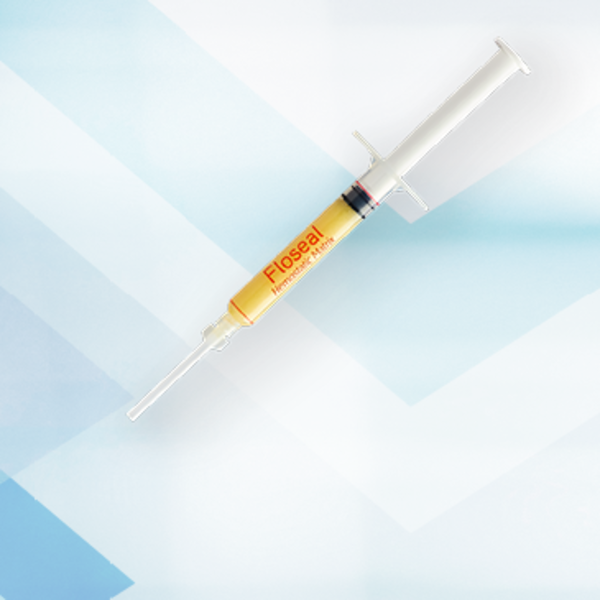Cardiovascular Surgery
Baxter understands that during cardiovascular surgeries blood management is essential to saving lives. Hemostats, sealants and tissue repair products need to work fast and facilitate access to difficult sites. Baxter created its portfolio of products to address those needs during times when life is on the line.
Each cardiovascular procedure provides unique challenges that can cause complications for the healing process. Here are a few examples:
Coronary Artery Bypass Graft (CABG)
In CABG surgeries, hemostats ensure the surgical field is visible and bleeding risks are minimized to optimize postoperative recovery. FLOSEAL, Baxter's flowable hemostat, actively achieves fast hemostasis (2 min median time to hemostasis)1 leading to improved clinical outcomes2 and reduced annual cost of care3.
Aortic Aneurysm Repair
During an aortic aneurysm repair, synthetic sealants can work independently of the coagulation cascade to prevent bleeding4,5. COSEAL, Baxter's fully synthetic sealant, provides a thin, translucent, motion-responsive seal that supports natural vascular dilation and can be sutured through, while allowing for visibility at the suture line6.
Portfolio of Products
Indications and Important Risk Information
Floseal Hemostatic Matrix Indication
FLOSEAL is indicated in surgical procedures as an adjunct to hemostasis when control of bleeding, ranging from oozing to spurting, by ligature or conventional procedures is ineffective or impractical.
Contraindications
Do not use FLOSEAL in patients with known allergies to materials of bovine origin.
Warnings
Do not inject or compress FLOSEAL into blood vessels.
Do not apply FLOSEAL in the absence of active blood flow, e.g., while the vessel is clamped or bypassed. Extensive intravascular clotting and even death may result.
FLOSEAL is not intended as a substitute for meticulous surgical technique and the proper application of ligatures or other conventional procedures for hemostasis.
FLOSEAL is not intended to be used as a prophylactic hemostatic agent to prevent postoperative bleeding.
Excess FLOSEAL Matrix (material not incorporated in the hemostatic clot) should always be removed by gentle irrigation from the site of application. Meticulous irrigation is required when used in, around, or in proximity to foramina in bone, areas of bony confine, the spinal cord, the brain and/or cranial nerves.
As with any implantable material, the use of FLOSEAL is not recommended in the presence of an active infection.
FLOSEAL should be used with caution in contaminated areas of the body. If signs of infection or abscess develop where FLOSEAL has been applied, re-operation may be necessary in order to remove the infected material and allow drainage.
Regardless of the type of surgical procedure, surgeons should consider the maximum swell volume of FLOSEAL, which is between 10 – 20%, after product is applied to source of bleeding and its potential effect on the surrounding anatomic areas. Maximum swell volume is achieved within about 10 minutes.
The safety and effectiveness of FLOSEAL for use in ophthalmic procedures has not been established.
FLOSEAL should not be used for controlling intrauterine post-partum bleeding or menorrhagia.
The safety and effectiveness of FLOSEAL has not been established in children and pregnant women.
Do not use FLOSEAL in the closure of skin incisions because it may interfere with the healing of the skin edges due to mechanical interposition of gelatin. The safety and effectiveness of the use of FLOSEAL Matrix as a carrier for antibiotic solutions or powders has not been established.
For safe and proper use of this device, please refer to the Instructions for Use.
CE 0123
Coseal is indicated for
- Sealing suture lines along arterial and venous reconstructions.
- Enforcement of suture and staple lines in lung resection procedures.
- Patients undergoing cardiac surgery to prevent or reduce the incidence, severity and extent of post surgical adhesion formation.
- Patients undergoing laparotomy or laparoscopic abdomino-pelvic surgery as an adjunct to good surgical technique intended to reduce the incidence, severity and extent og post surgical adhesion formation.
Contraindications
Do not use Coseal as a bronchial stump sealant, during bronchial sleeve resections, or for sealing decorticated lung areas.
Do not use Coseal in procedures in which pleural adhesions are desired.
Warnings
Coseal swells up to four times its volume within 24 hours of application and additional swelling occurs as the gel resorbs. Therefore surgeons should consider the maximum swell volume and its possible effect on surrounding anantomic structures potentially sensitive to compression
Rx only: For safe and proper use of this device, please refer to full device Instructions for Use.
CE 0123


